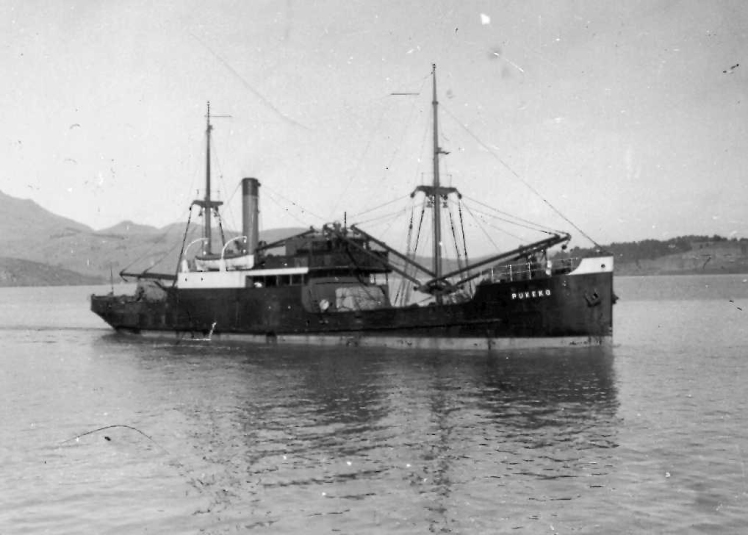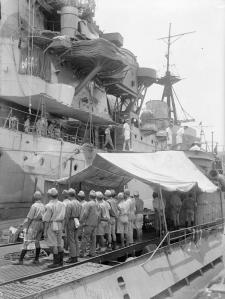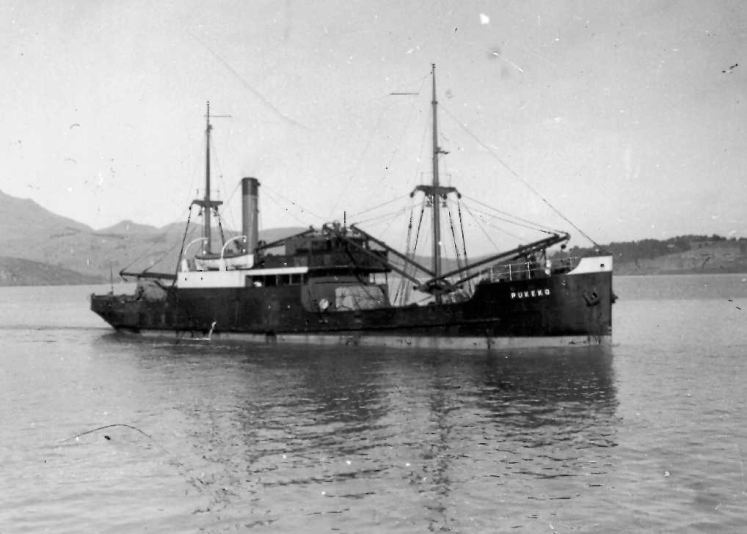By January 1945 the Second World War had long turned in favour of the Allies. Germany was on the retreat across Europe, and Japan had been pushed back to a shrinking perimeter around the Home Islands. The idea of a U-boat turning up off the New Zealand coast that month was unthinkable. But a U-boat attack in strange waters is exactly what happened.
U-181 or U-862 at Singapore after the Japanese surrender in August 1945, by which time the German U-boats in the Far East had been appropriated by the IJN. Public domain, via Wikipedia.
The German Type IX-D2 submarine U-862, Käpitanleutnant Heinrich Timm, was a long-range boat with a secondary role shipping high-value, small-volume cargoes. The boat was commissioned in October 1943 and based in Narvik. Timm spent some months working his command up to fighting efficiency, and in May 1944 was despatched to the Far East with a small cargo. In Singapore, the boat joined the 33rd U-Boat flotilla, Monsun Gruppe, Germany’s small Far Eastern U-boat pack.
By this time the Allies had sea supremacy, but for Timm there were many possibilities. In December 1944, he took the U-boat on a long patrol into southern waters, running down Australia’s west coast, south of Tasmania, then towards Sydney. Then he took the boat across the Tasman and down the eastern coastline of New Zealand’s North Island.
Timm found no opportunities off Gisborne and Wairoa, and at dusk on 16 January 1945 motored on the surface across Hawke Bay to Napier. The moment has been thoroughly mythologised; there were even suggestions that he entered Napier’s breakwater harbour, or that the crew went ashore and milked cows – which led to a stage play, U-boat Down Under, performed in Wellington during 2006. It was all untrue. The dairy raid story, it seems, originated from a tall tale Timm told Air Vice-Marshal Sir Rochford Hughes when they were both working for NATO in the 1950s; each was reportedly trying to out-do the other with their wartime exploits which, it seems, rather grew in the telling.
In fact Timm’s men never landed. But the reality of the moment was still extraordinary. Early in the war, a small number of German auxiliary cruisers – armed merchantmen – operated in Australasian waters and into the South Pacific; but their day had been relatively brief. By 1945 the tides of war had taken any likely enemy far from the South Pacific, and even blackout – first imposed in February 1941 – had been lifted in New Zealand’s coastal towns.
Napier’s breakwater harbour in April 1951, virtually unchanged from its 1945 configuration. The Harbour Board dredge is working on the channel, centre frame. The town centre and beach is out of frame to the left (south); the Westshore urban district out of frame to the right. Credit: White’s Aviation collection, Napier Port and Harbour. Ref: WA-27430-F. Alexander Turnbull Library, Wellington, New Zealand. /records/22831914
Timm’s arrival off Napier’s small breakwater harbour was unspectacular. He apparently knew about the beacons marking the channel in. It is not true that he entered it. Although new wharves were opened in 1939 and 1943,[1] and a harbour dredge was occasionally put to work with ear-shattering noise that could be heard across town, the artificial harbour was still shallow in 1945 and ships had to quit the place in certain tides and swells. It was a tight harbour, and Timm had virtually no chance of entering undetected, or of manoeuvering safely even if he did.[2] Nor was there any purpose to his trying.
The only vessel in harbour that night was the 735 grt coastal freighter Pukeko, owned by local shipping company Richardson & Co; but Timm knew none of this as his boat idled through the sea with the town spread out before them. It was a hot summer night. Napier enjoyed a Californian climate; and the German sailors saw what they thought were street cafes, watching what they imagined were couples dancing to jazz music that echoed across the quiet water.[3] For the U-boat crew the sight was significant; they had been beset by war since 1939, and here was a town apparently enjoying peacetime life.
Exactly what the Germans were seeing, however, is another matter, because although there were a few private hotels down the Marine Parade that ran along the waterfront, Napier had no waterfront cafes in 1945. However, there was a popular roller-skating venue on the main foreshore, near a Soundshell that had been deliberately styled after the Hollywood Bowl. No formal events were scheduled there that night, but in all likelihood private citizens were gliding across the concrete, probably appearing as dancers to the watching Germans offshore as they idled south past the harbour breakwater. Further up the waterfront just, a few hundred metres south of the breakwater harbour, the city’s shoreline salt-water baths were jammed with spectators watching a swimming championship.[4]
Napier’s main city beach and foreshore, a 1940s photo by William Hall Raine. The city salt water baths are in the foreground, then a park with art deco style fountain; then the Soundshell with the skating rink before it, middle distance adjacent to the modernist ‘T&G” building. It is likely that this skating rink is what the crew of U-862 saw. Credit: Ref: 1/1-018054-G. Alexander Turnbull Library, Wellington, New Zealand. /records/22564858
Timm continued to idle the U-boat offshore, and a few hours later the Pukeko left harbour with running lights on as if it were peacetime. Timm followed, attacked as dawn came — and missed. A sailor on deck saw the trail as the torpedo ran past, but the idea of a torpedo attack off Napier – at any stage in the war – was so remote he thought he had imagined it.[5] However, the ship had indeed been attacked, and the torpedo is still at the bottom of the bay. Decades later, the Royal New Zealand Navy attempted to find it with modern sonar, but an initial sweep drew a blank.
Pukeko in Lyttleton harbour. Credit: Photographer and copyright unknown, via http://www.shipsnostalgia.com/gallery/showphoto.php/photo/317995/title/pukeko28i-29/cat/518
Timm stalked Pukeko until she began signalling the Portland Island signal station northeast of Napier, at which point he decided his U-boat had been seen and abandoned the pursuit. Next day he was ordered to abandon the cruise,[6] and left New Zealand waters.
For the full story of enemy action in New Zealand waters during the Second World War, check out my book Blue Water Kiwis, available on Amazon. Click to buy. Want to read more submarine articles? Check out my post detailing the rise of the perfect stealth warship. Check out other great articles on the Navy General Board Home Page.
Copyright © Matthew Wright 2018
[1] M. D. N. Campbell, The Story of Napier, p. 184.
[2] Matthew Wright The History of Hawke’s Bay, Intruder Books, Wellington 2017, pp. 166-167.
[3] David Stevens, U-Boat Far from Home, Allen & Unwin, St Leonards, 1997, p. 182.
[4] The Daily Telegraph, 16 January 1945.
[5] Matthew Wright, ‘New Details Uncovered – U Boat Attack in Napier’, Daily Telegraph, 26 June 1997.
[6] Stevens, p. 183.








Recent Comments